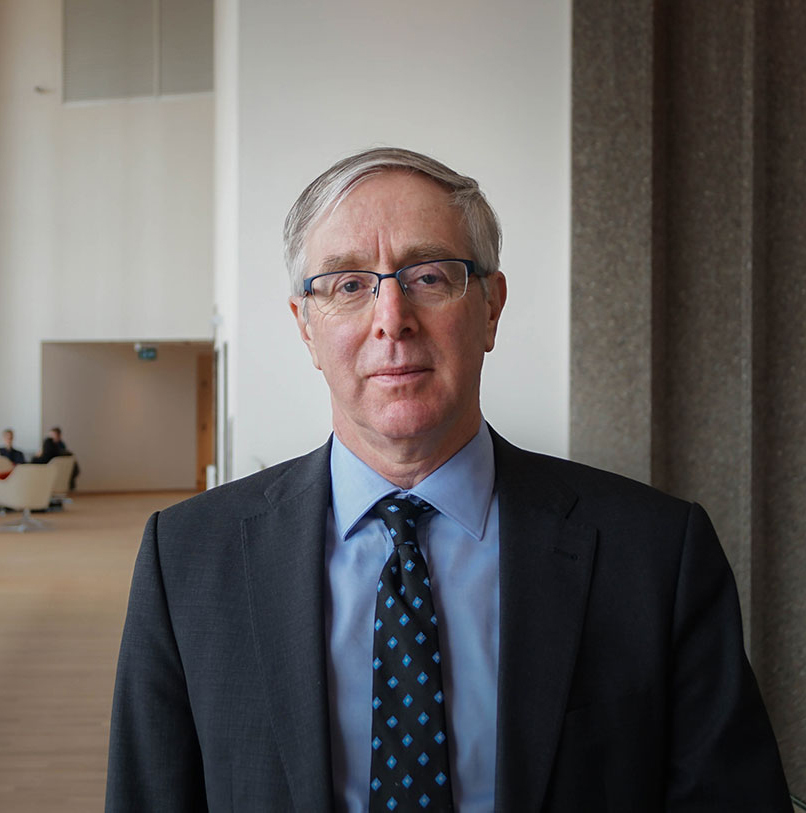This is the first part of Convivium's series on homelessness, addiction, and mental illness. Click here to read part two: "Starting to Stop Every Day."
On the wall of his Hastings Street office on Vancouver’s Downtown Eastside, someone has done a felt marker graffiti style depiction of Ronnie Grigg that calls him an “Urban Legend” and Canada’s Jesus.
Whether he is either of those things, Grigg is certainly a highly visible face, not to mention a physically imposing body, for the care and comfort of the afflicted in a neighbourhood where affliction has become a deeply embedded form of normal.
Well over six feet tall, with an apostolic length beard, and a big-man’s classic counterpoint voice of soft thoughtfulness, Grigg cannot walk anywhere in the Downtown Eastside without being “hey Ronnie’d,” smiled at, frequently hugged. Now the manager of the Overdose Prevention Society, Grigg began his work here in the days when the then relatively new Insite safe injection site became ground zero for the fentanyl epidemic that erupted a few years ago.
He was among those who routinely rushed out in the dark and the rain to rescue overdosed addicts from back alley mud puddles. He also made a point of moving into the area so that the people he dealt with during his working hours weren’t mere clients. They were – and are – his neighbours in the very neighbourhood where serial killer Robert Pickton was able to kidnap an estimated 49 female victims without anyone in authority even noticing.
To call it grim would be to give it the patina of a fairytale. It has, to fresh sensibilities, the nightmarish quality of Edgar Allan Poe’s brain after a night spent drinking cleaning products in the gutters of 19th century Baltimore. But it is also, in Grigg’s deeply experienced eyes and emphatic understanding, a community where those who survive can find healing and even home. The ability to accept it that way, he says, relies on how we are prepared to calculate success.
Success here, Grigg notes, means helping an overdose victim take a first breath back to consciousness. It means getting water into a dehydrated addict high for days on end. It means helping someone in the midst of mania – drug induced or otherwise – find a place to manage a few hours of frantically needed sleep.
“I’m not saying there’s no need to be moved into a system that can provide longer term help. But first you have to breathe, get water into your body, be able to sleep,” he says.
The definition might sound starkly elemental, but it’s also the most concrete, specific definition of success I heard during weeks of interviews with those who work with, live among and are themselves affected by the triangulation of homelessness, addiction and mental illness not just in Vancouver’s Downtown Eastside, but across Canada.
“We hear a lot of talk about amalgamating services or setting up another task force improving communication, but that’s still spinning wheels in a system that was never constructed from the human perspective to begin with,” says researcher Alina Turner from Calgary.
“All these strategies and techniques and busy work, if they’re not related back to that human experience, and what a person needs, they’re irrelevant.”
If so, it would be hugely expensive irrelevance. As in at least $33.5 billion a year expensive. In a paper published at the end of January through the University of Calgary’s School of Public Policy, Turner and her colleague Diana Krecsy calculate that’s how much Canada spends each year on 167,000 services stretched across both government and non-profit agencies.
Combining tax data and public accounts records, Turner and Krecsy put the country’s annual funding for homelessness and its related traumas such as poverty, mental illness, addiction, domestic violence at $27 billion. Another $6.5 billion a year is spent on social assistance programs, health care, and the policing-justice system when they intersect with homelessness.
Ontario alone has 60,000 social and community services seeking to alleviate the acute effects and chronic causes of such social ills. Alberta has 20,000. And, Turner stresses, those numbers aren’t the full spending picture.
“This is just for the components we can actually get data on. There’s also a huge private sector social service side of the ecosystem that we haven’t even started to understand because the rules for (private sector data) that can be accessed and published are very different from the public sphere. I can ask for open data on a charity, but I can’t just go to any private business and say, ‘I want to see your budget.’ So, what we do know represents a pretty big number. It could be a lot bigger.”
Yet as Turner and Krescy write in their report “Bringing It All Together: Integrating Services to Address Homelessness” the known (and unknown) dollar figure provides no certainty about whether anything effective is being done to minimize, much less eliminate, homelessness.
“No clear line of sight exists between the $33.5 billion annual investment and the current client and population outcomes,” they write. “Integration is so much more than piecemeal strategies aimed at repairing a broken system. It is a full-scale transformation if that system. The work needs to begin.”
Almost from the beginning of my interviews and research into the relationship between homelessness, addiction and mental health, I was struck by two things. The first was the total commitment of those in the field to doing their absolute best for those they seek to help. The second was the extent to which help seemed to arrive by what seemed to be, in an extraordinary number of cases, random chance.
It was as if service and need were, all too often, standing on the same street corner looking down the avenue in opposite directions. Good things happen when they turn and notice each other. All too often, it seems, they don’t, bringing Ronnie Grigg and others who do his kind of work across Canada running to pull victims out of mud puddles in the dark.
Over the next few Mondays on Convivium, we’ll be presenting the stories of those caught in the web of homelessness, those who’ve managed to break free, those on the front lines helping them, and those doing truly forward-thinking research on how to make the best-intentioned, but not always most effective, system work the way everyone wishes it would.
The stories are equally heart-wrenching and hope filled but all carry the implicit recognition that, as Ronnie Grigg put it, the first marker of success is regaining the capacity to breathe.
Click here to read part two: "Starting to Stop Every Day."






